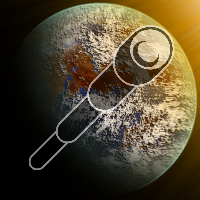Gravity Plates
About Solaris | Guide to Solaris | Prologue
Space Health
Gravity plates are most useful for stations with long-term inhabitants as it makes daily life much easier for those not used to microgravity. They are a luxury feature, and a particularly appreciated one, as they enable simple enjoyments such as showers and sitting at a table to dine. Jovians are used to even higher gravity, and the more influential Senators might even refuse to stay at a station without a gravity plate installed. Gravity plates are also beneficial for staying healthy in space. Resisting the pull of gravity naturally exercises one's muscles and strengthens bones, so staying fit in microgravity requires extra effort in the form of regular exercise. With gravity plates, space denizens don't need to do any of that.Two Faces
Through The Gravity Plate
Traveling through a gravity plate is an unpleasant experience. You can feel half of your body being pulled strongly in one direction and the other half in the complete opposite one. It also takes a fair amount of physical effort and coordination to lift one's body through the plate. Those not used to the feeling might become sick after transiting the plate, if they succeed at all. Stations are usually designed so normal visitors don't need to travel through the plate. Smaller stations might place their maintenance facilities and machinery on the opposite side of the plate as to the public area. Bigger stations use elevators that travel just inside the edge of the gravity field's effect in order to fully utilize each plate.Manufacture
In the past, gravity plates were exclusively produced by a single company, Gravimetrics Unlimited, owned by Quo, a Merchant Prince of Saturn . The methods and materials were kept a close secret. After many attempts by rival Princes, one spy was able to steal the secret of gravity plates. It was posted on SWAN, ensuring that the gravity plate monopoly was forever ended, though the precise series of events that led to this happening is not known. Speculation abounds, and at least one dramatization, Prometheus, God of Gravity, portrays it as a last ditch effort to democratize gravity plate technology. Even with the method of manufacture revealed, Gravimetrics Unlimited did not go bankrupt. Making gravity plates is a precision process, and Gravimetrics had the advantage of a fully established process and secure sources of oortite directly from Pluto. Plus, ship and stationbuilders are often conservative when switching providers. The company's massive profit margin was still severely undercut, though. Today, gravity plate manufacturers exist on Mars, Luna, Jupiter, and Saturn.Oortite Gold Rush
| Crystal Technology | ||||||||
|---|---|---|---|---|---|---|---|---|
|









Reading about this made me think of how we take gravity for granted. XD RIP to the underprepared people of the oortite gold rush.
Yes! It's so wild that our own bodies just start wasting away if we spend too much time without it. Unlike California, the Kuiper Belt is very very *very* dangerous...